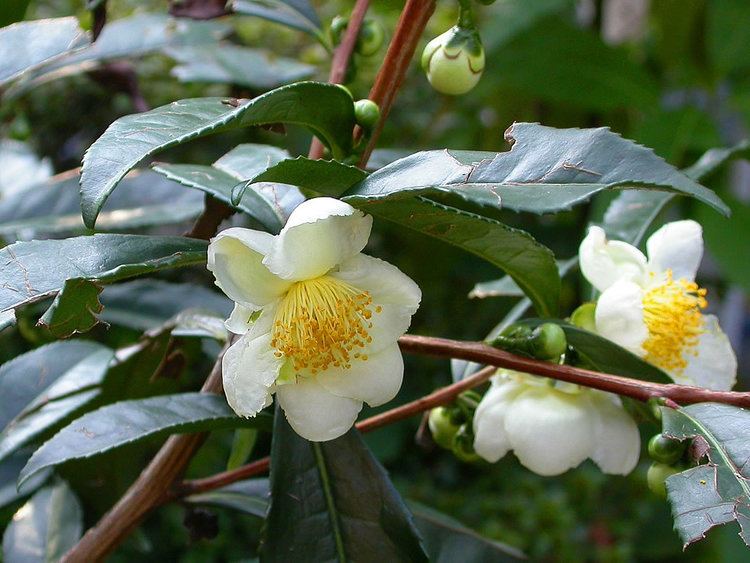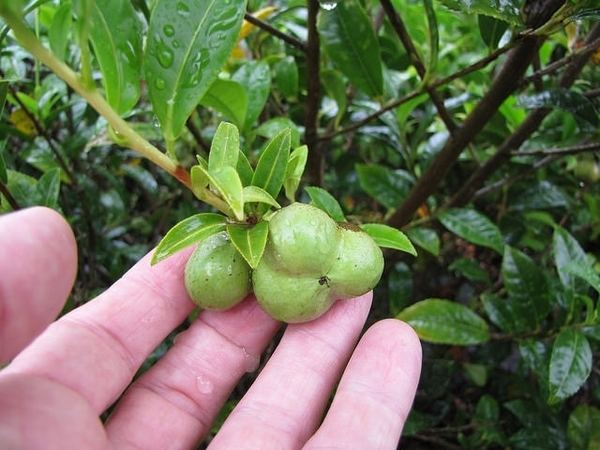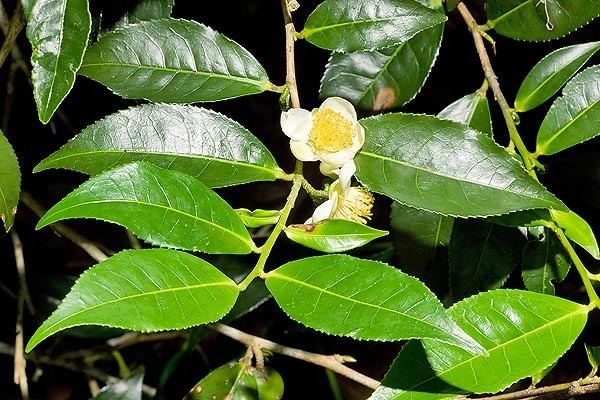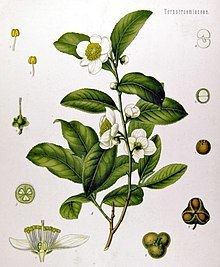Scientific name Camellia sinensis Higher classification Camellia | Genus Camellia Rank Species | |
 | ||
Similar Camellia, Theaceae, Narrow‑leaved paperbark, Japanese camellia, Camellia oleifera | ||
How to harvest a tea plant camellia sinensis tea pursuit
Camellia sinensis is a species of evergreen shrub or small tree whose leaves and leaf buds are used to produce tea. It is of the genus Camellia (Chinese: 茶花; pinyin: Cháhuā, literally: "tea flower") of flowering plants in the family Theaceae. Common names include "tea plant", "tea shrub", and "tea tree" (not to be confused with Melaleuca alternifolia, the source of tea tree oil, or Leptospermum scoparium, the New Zealand teatree).
Contents
- How to harvest a tea plant camellia sinensis tea pursuit
- Tea me ep1 tea plant camellia sinensis
- Nomenclature and taxonomy
- Cultivars
- Description
- Cultivation
- Chinese teas
- Indian teas
- Pests and diseases
- Health effects
- References

Two major varieties are grown: Camellia sinensis var. sinensis for Chinese teas, and Camellia sinensis var. assamica for Indian Assam teas. White tea, yellow tea, green tea, oolong, pu-erh tea and black tea are all harvested from one or the other, but are processed differently to attain varying levels of oxidation. Kukicha (twig tea) is also harvested from Camellia sinensis, but uses twigs and stems rather than leaves.

Tea me ep1 tea plant camellia sinensis
Nomenclature and taxonomy

The name Camellia is taken from the Latinized name of Rev. Georg Kamel, SJ (1661–1706), a Moravian-born Jesuit lay brother, pharmacist, and missionary to the Philippines.
Carl Linnaeus chose his name in 1753 for the genus to honor Kamel's contributions to botany (although Kamel did not discover or name this plant, or any Camellia, and Linnaeus did not consider this plant a Camellia but a Thea).
Robert Sweet shifted all formerly Thea species to the Camellia genus in 1818. The name sinensis means from China in Latin.
Four varieties of Camellia sinensis are recognized. Of these, C. sinensis var. sinensis and C. sinensis var. assamica (JW Masters) Kitamura are most commonly used for tea, and C. sinensis var. pubilimba Hung T. Chang and C. sinensis var. dehungensis (Hung T. Chang & BH Chen) TL Ming are sometimes used locally.
Cultivars
Cultivars of C. sinensis include:
Description
Camellia sinensis is native to East Asia, the Indian Subcontinent and Southeast Asia, but it is today cultivated across the world in tropical and subtropical regions.
Camellia sinensis is an evergreen shrub or small tree that is usually trimmed to below 2 m (6.6 ft) when cultivated for its leaves. It has a strong taproot. The flowers are yellow-white, 2.5–4 cm (0.98–1.57 in) in diameter, with 7 to 8 petals.
The seeds of Camellia sinensis and Camellia oleifera can be pressed to yield tea oil, a sweetish seasoning and cooking oil that should not be confused with tea tree oil, an essential oil that is used for medical and cosmetic purposes, and originates from the leaves of a different plant.
The leaves are 4–15 cm (1.6–5.9 in) long and 2–5 cm (0.79–1.97 in) broad. Fresh leaves contain about 4% caffeine, as well as related compounds including theobromine. The young, light green leaves are preferably harvested for tea production; they have short white hairs on the underside. Older leaves are deeper green. Different leaf ages produce differing tea qualities, since their chemical compositions are different. Usually, the tip (bud) and the first two to three leaves are harvested for processing. This hand picking is repeated every one to two weeks.
Cultivation
Camellia sinensis is mainly cultivated in tropical and subtropical climates, in areas with at least 127 cm. (50 inches) of rainfall a year. Tea plants prefer a rich and moist growing location in full to part sun, and can be grown in hardiness zones 7 – 9. However, the clonal one is commercially cultivated from the equator to as far north as Cornwall and Scotland on the UK mainland. Many high quality teas are grown at high elevations, up to 1,500 meters (4,900 feet), as the plants grow more slowly and acquire more flavour.
Tea plants will grow into a tree if left undisturbed, but cultivated plants are pruned to waist height for ease of plucking. Two principal varieties are used, the small-leaved Chinese variety plant (C. sinensis sinensis) and the large-leaved Assamese plant (C. sinensis assamica), used mainly for black tea.
Chinese teas
The Chinese plant (sometimes called C. sinensis var. sinensis) is a small-leafed bush with multiple stems that reaches a height of some 3 meters. It is native to southeast China. The first tea plant to be discovered, recorded and used to produce tea three thousand years ago, it yields some of the most popular teas.
C. sinensis var. waldenae was considered a different species, Camellia waldenae by SY Hu, but it was later identified as a variety of C. sinensis. This variety is commonly called Waldenae Camellia. It is seen on Sunset Peak and Tai Mo Shan in Hong Kong. It is also distributed in Guangxi province, China.
Indian teas
Three main kinds of tea are produced in India:
Pests and diseases
Tea leaves are eaten by some herbivores, like the caterpillars of the willow beauty (Peribatodes rhomboidaria), a geometer moth.
Health effects
The leaves have been used in traditional Chinese medicine and other medical systems to treat asthma (functioning as a bronchodilator), angina pectoris, peripheral vascular disease, and coronary artery disease.
Among other interesting bioactivities, (-)-catechin from C. sinensis was shown to act as agonist of PPARgamma, nuclear receptor that is a current pharmacological target for the treatment of diabetes type 2.
Tea may have some negative impacts on health, such as over-consumption of caffeine, and the presence of oxalates in tea.
